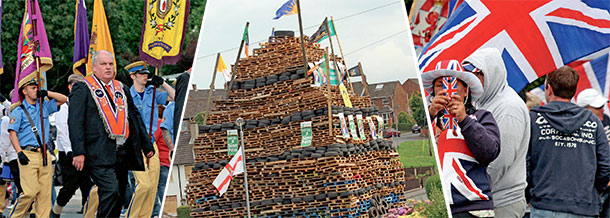1 June 2015 Edition
Here comes summer
The way forward for parades and peace in ‘the marching season’

• Political unionism and loyalism attempted to combine to undermine the Parades Commission
Clearly, the best way to achieve resolutions – as evidenced in Derry City, Crumlin and Maghera – is for parade organisers and local residents to engage in direct and meaningful talks to resolve disputes
WITH THE DAWN of the spring, as we leave another winter behind us, society normally looks forward to the emergence of summer with its long nights and (hopefully) sunny days. In a number of areas across the North afflicted by contentious parades, however, the prospect of another summer evokes a sense of dread as local communities experience the annual rise in tension associated with the advent of another parading season.
The small number of contentious parades held so far this year have passed without major incident. So what are the prospects for another relatively peaceful summer similar to last year?
Last July, we witnessed a walk-out from the party leaders’ meetings by Peter Robinson’s Democratic Unionist Party and Mike Nesbitt’s Ulster Unionist Party as news of the Parades Commission determination filtered out ensuring no return parade through Ardoyne on the Twelfth.
Subsequently, at a press conference incorporating the full spectrum of unionists/loyalist opinion, the concept of a “graduated response” was outlined. In essence, political unionism and loyalism would combine to undermine the Parades Commission while pressuring the NIO to reverse the decision. Neither the concept nor the pact lasted long as no obvious strategy came into play and internal bickering led to the pact imploding. In the worlds of one prominent loyalist: “We were sold a pup.”
One positive consequence of this development was that it led to a relatively peaceful summer. Loyalist violence would have undermined any attempt to influence the NIO and key Tory supporters.
Last autumn, in response to unionist pressure, British Secretary of State Theresa Villiers launched a one-sided initiative in the form of a mediation panel with a remit to mediate an agreed accommodation. It received an immediate rebuke from local residents in Ardoyne, Sinn Féin and the SDLP and was finally buried at the conclusion of the Stormont House Agreement last December.
In March, the Orange Order commissioned an ‘independent review’, inviting the Francis Hutcheson Institute to produce a report by early June, clearly designed to influence this year’s decision on the Ardoyne parade.
The impartial credentials of the institute itself were tarnished when it emerged its ‘Director of Communications’ and ‘Political Consultant’ was Lord Laird of Artigarvan. The Ulster Unionist peer and former Stormont MP is a staunch defender of loyalist bands and loyal order parades.
From a nationalist residents’ perspective, such ‘initiatives’ are clearly designed to undermine the Parades Commission. This body has a statutory remit to adjudicate on all contentious parades and related protests. Its decision-making process is established within the framework of the European Convention on Human Rights (ECHR). In addition, the Public Procession (NI) Act 1998 which established the Parades Commission also obliges it to have regard to certain criteria for adjudication (e.g. disruption to the life of the community, public order and the impact on community relationships, etc).
During the Stormont House talks on parades last December, three key issues emerged:
- Code of conduct for participants
- Criteria for adjudication
- Role and accountability of parade/protest organisers.
The unionist position was:
- Self-regulation
- A reduced set of criteria
- A refusal to recognise the clear responsibilities of the parade/protest organisers.
By contrast, Sinn Féin, the SDLP and Alliance argued for a robust code of conduct to shape behaviour, a strong set of criteria and a legal responsibility to be placed on organisers to ensure compliance with determinations and, in its absence, legal culpability.
So, at a political level, a gulf exists between positions. But this can be narrowed if political unionism grasps the nettle and acknowledges that it is in all our interests to remove contention from parades. The consequences would reverberate across society in a positive and progressive manner.
As outlined in the Stormont House Agreement, a range of options will be presented to the parties this month on how the key issues outlined above could be addressed in legislation.
Irrespective of closing the gap in political positioning around parading, what is required is a change in the mind-set by the loyal orders and bands. This requires a recognition that parading disputes reflect competing interests and rights. No right to parade is absolute, despite a recent DUP promise to legislate for such a position.
Clearly, the best way to achieve resolutions – as evidenced in Derry City, Crumlin and Maghera – is for parade organisers and local residents to engage in direct and meaningful talks to resolve disputes. Surely we can reach a scenario where both the loyal orders and nationalist residents recognise and respect each other’s positions, devoid of supremacism and sectarianism.




